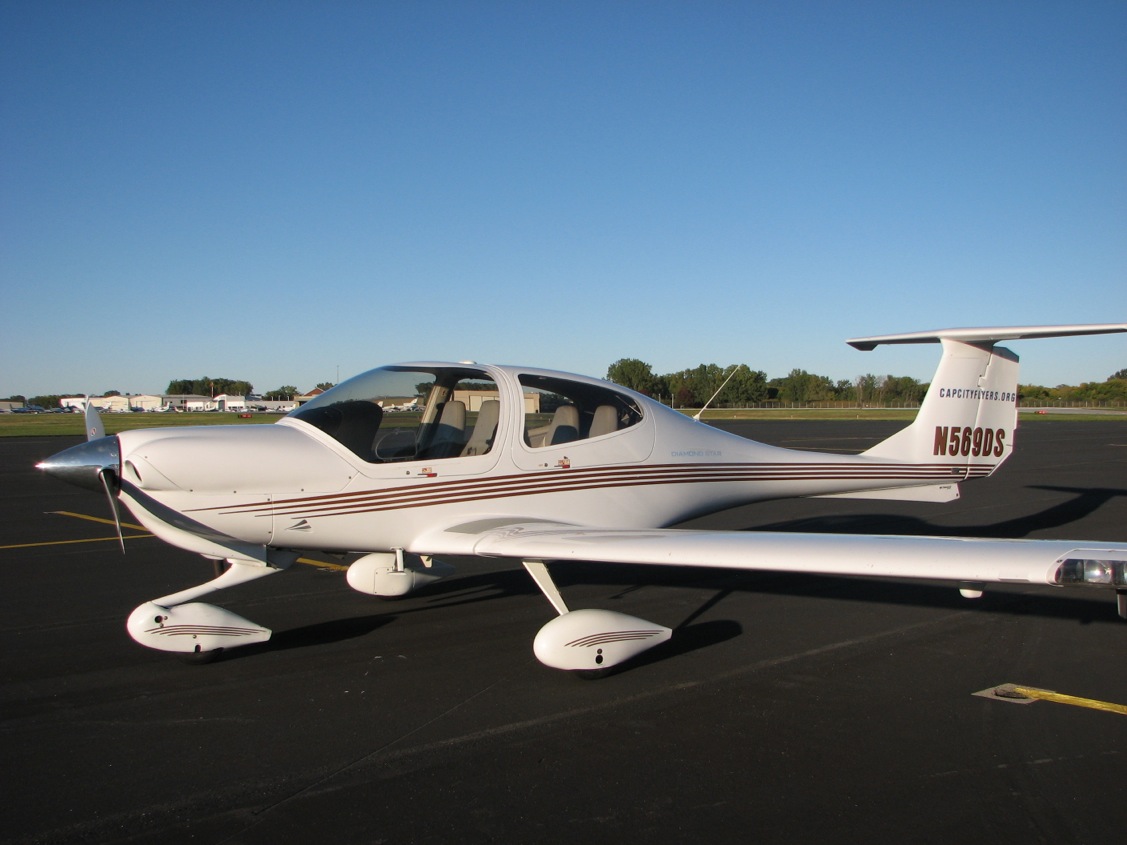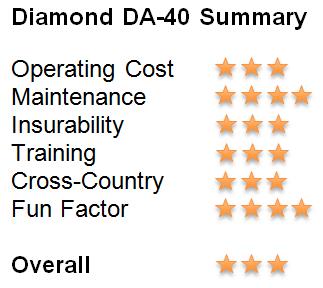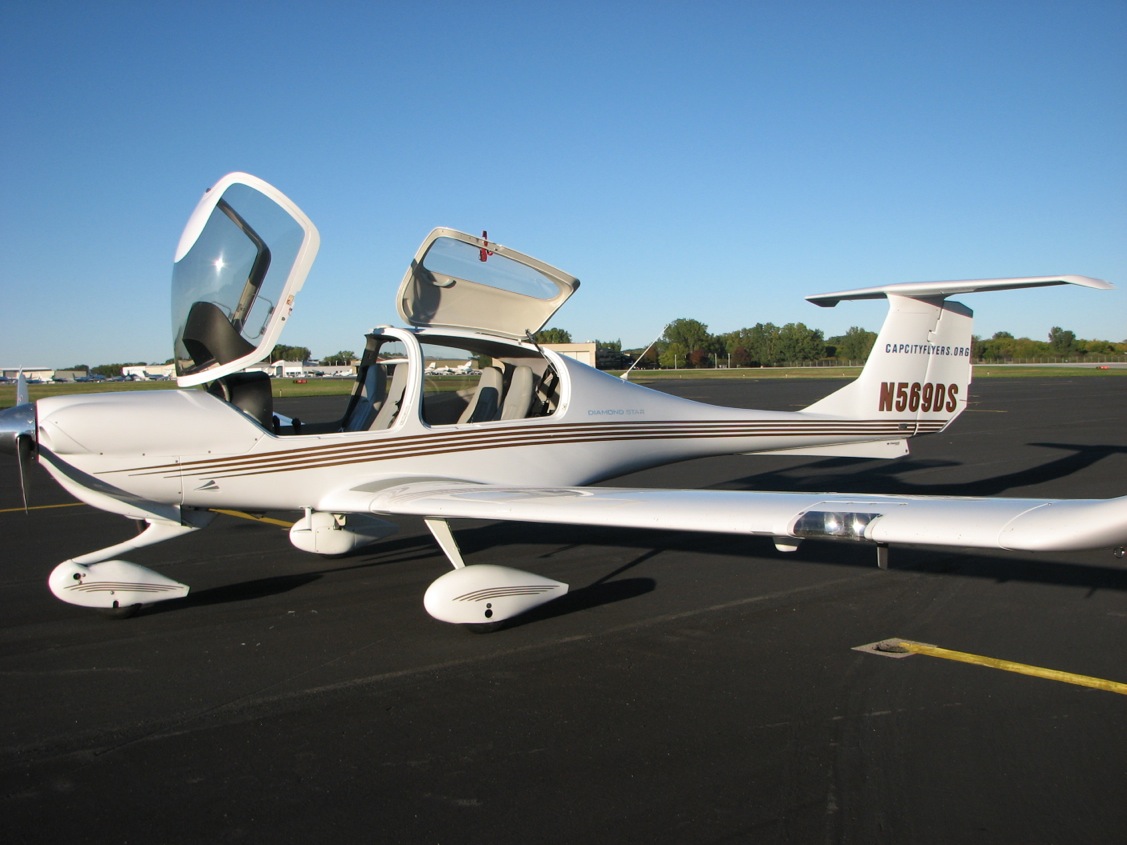 The Aircraft Spotlight feature looks at an airplane type and evaluates it across six areas of particular interest to flying clubs and their members: Operating Cost, Maintenance, Insurability, Training, Cross-Country, and Fun Factor.
The Aircraft Spotlight feature looks at an airplane type and evaluates it across six areas of particular interest to flying clubs and their members: Operating Cost, Maintenance, Insurability, Training, Cross-Country, and Fun Factor.
This month we look at the 4 place Diamond DA-40 operated by the Capitol City Flyers in Madison, WI. We talked to Club President Colin Maitland about their 2006 model DA-40. An online search showed at least 8 other flying clubs also operating the DA-40.

Operating Cost (3 stars)
Capitol City’s hourly rate for the Diamond of $150/hour (tach, wet) is comparable to what the club charged for its Cessna 182, which was destroyed in a windstorm earlier this year. The aircraft burns anywhere from 7 to 12 gph depending on power settings.
However, the Diamond’s tach doesn’t start until the aircraft hits 30 knots, where in the Archer and 182 the tach is calibrated on 75 percent power, so it’s spinning slowly while you’re taxiing. “The Diamond ends up saving you money because you aren’t charged for any of your taxi time,” Colin said.
Maintenance (4 stars)
Overall, Capitol City Flyers have found maintenance costs to be reasonable. Buying a newer aircraft, there aren’t the same concerns or costs you might have with an older, used aircraft. Colin noted the annuals have run between $1,500 and $2,500, similar to what the club pays for its Archer and 182.
It has a 180-hp, fuel-injected Lycoming engine, so there’s a lot less fouling of the plugs and it’s not hard to find a mechanic who is familiar with the engine.
However, there are a few things to keep an eye on. The DA-40 has a free-castering nose wheel and uses differential braking to steer. Therefore the brakes might need to replaced sooner than in an aircraft with a directional nose wheel. It may be more difficult to find a maintenance shop that can handle working on a composite airframe in the case of any hangar rash or structural issues.
“The only thing we’re really struggling with, and it’s not a major issue, is that a lot of the parts have to come from Canada and sometimes there is a little bit of a lag in getting parts for repairs,” Colin said. “Particularly if you have to order a battery from Canada. It’s hazardous material.” 
Insurability (3 stars)
When the Capitol City Flyers were looking to upgrade to a newer, faster aircraft its insurance company wouldn’t insure a Bonanza, Mooney, or Cirrus in a club environment. However, the Diamond was acceptable and relatively easy to insure, Colin said.
Capitol City pays $6,800 a year to insure the Diamond, which is about twice as much as the club’s Archer. The difference is mostly because of the increased hull value ($40,000 for the Archer compared with $160,000 for the Diamond).
The only requirement the insurance company has for the airplane is that pilots take a G1000 ground school. The club established minimums for a checkout—pilots with less than 150 hours total time are required to have 10 hours in type, pilots with more than 150 hours TT are required to have 5 hours in type.
Training (3 stars)
Although Capitol City Flyers don’t allow primary training, the DA-40 is capable of this role, and is used by several flight schools and university training programs. Capitol City Flyers does allow members to use it for advanced training like an IFR or commercial rating. Where the airplane is particularly valuable is in transition training to a modern glass panel and autopilot setup.
Cross Country Travel (3 stars)
The aircraft can cruise at 135 to 145 knots, which is faster than either the Archer or the club’s old 182. The G1000 with XM weather, traffic advisories, and terrain awareness, as well as an autopilot with altitude preselect provides plenty of technological features that a pilot would want on a cross-country. Club members have used the plane for trips to San Diego, Arkansas, and Florida.
However, the Diamond is a little weak on payload. “It’s not really a four-person aircraft. It’s a good two-person aircraft.” Colin said. Capitol City had modifications done to increase the gross weight and performance. The plane has extended range tanks that hold 50 gallons of fuel and about 600 to 650 pounds of useful load. A standard DA-40 from the factory has a 40-gallon fuel tank and about 500 pounds of useful load.
Fun Factor (4 stars)
Whoever said, “image is everything” must have had the Diamond in mind. With its tapered fuselage and clean, modern cockpit dominated by the G1000 it makes a great impression. Having a stick instead of a yoke doesn’t hurt either.
“The younger members like the new stuff [modern avionics] and when you’re taking passengers for lunch, do you want to take them in this nice, new, sexy plane or do you want to take them in an old Archer with steam gauges?” Colin asked rhetorically. “My wife doesn’t fly a lot but when she does, she always asks, ‘Are we taking the new plane?’”
Overall (3 stars)
If your club is looking for something faster, sexier, and newer than the Pipers and Cessna’s that dominate most flying club fleets, the DA-40 may fit the bill. While it sacrifices a bit in payload, the speed, glass cockpit, and image more than make up for it. “It’s the most flown aircraft in our fleet,” Colin said. “People love it. It flies really nice.”
If you’d like to learn more, AOPA has an online fact sheet that covers the Diamond’s history, performance specifications, model variations and flying characteristics.